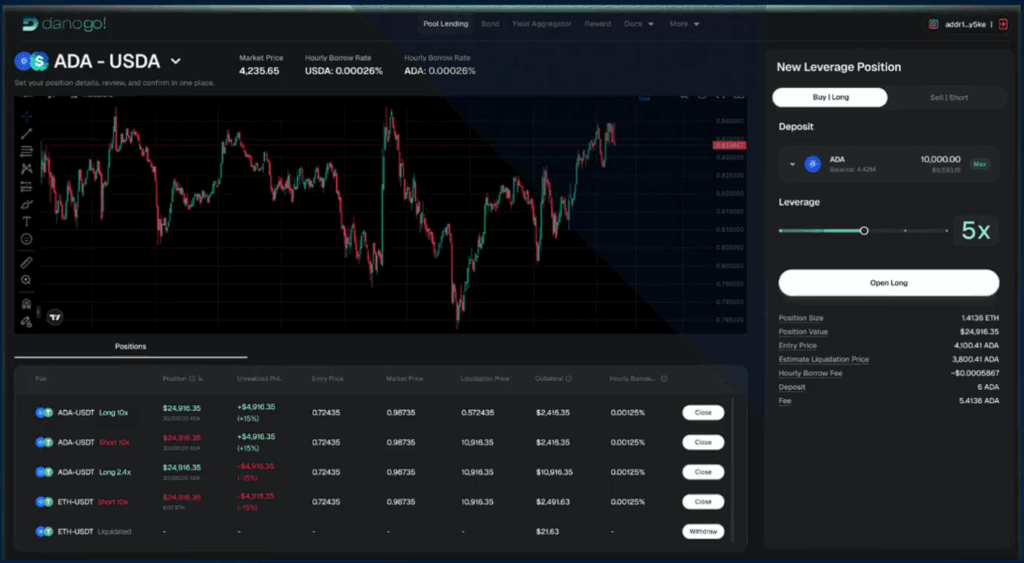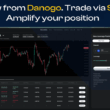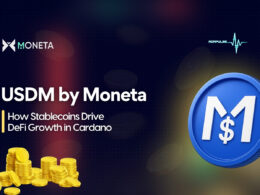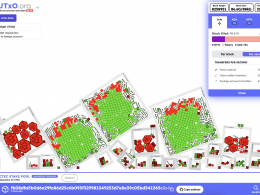In the first article of this series, we introduced leveraged trading on DeFi, explained how it differs from the traditional markets, and explained the Danogo Flexible Lending pool, which powers the trading ecosystem.
In this post, we break down Danogo’s approach to leveraged trading and its integration with Splash for operation. We’ll teach the steps of leveraged trading and use hypothetical numbers to build understanding. Before closing out, we’ll compare Danogo to worthy competitors like Strike, and wrap up with a note on the future of leverage trading in DeFi.
Leveraged Trading on Cardano: The Danogo Approach
In the Cardano DeFi, the Danogo leveraged trading platform was built to address the need for reliable trading options that let you amplify gains and cushion against risks with confidence. At this point, the flexible lending pool provides capital with which users open either long or short positions swapped on a supported DEX in a single transaction. Danogo’s leverage is up to x5.
Here are some unique features that make the Danogo leveraged trading unique:
- Accessibility through reduced capital requirements — An inclusive, capital-efficient trading markets that serve speculative traders, hedgers, and DApp developers building in the Cardano DeFi space.
- Flexible trading and collateral options — A diverse marketplace that supports multiple trading pairs for all the above-mentioned trading profiles, backed with the ability to provide collateral in one of the many supported variety of assets.
- Integrated leverage processing — A protocol that supports borrowing, swapping, and position creation in a single transaction, making it one of the easiest to use.
- Dynamic risk control — A market-driven protocol that continuously monitors loan health through oracles with parallel liquidation for response in rapid market turndowns.
- Integrations with other protocols — A flexible platform where idle collateral is routed to external yield-generating protocols. Danogo allows yield-generating collateral to be used in leveraged positions.
- Customizable trade execution — A system that supports auto-leverage opportunities, one-click portfolio rebalancing, and event-triggered hedging so you have the best trading position management.
- A Cardano-aligned protocol — A decentralized and transparent ecosystem auditable by anyone in the Web3 ecosystem, whilst empowering traders and protocols alike.
If sought by ‘takeaway,‘ the key point here is that Danogo is the lending and leveraged orchestration platform. It then leaves us with the other half of the piece, which the DEX used to execute swaps. Enter the Splash Protocol.
What Is Splash, and How Does It Enable Leverage?
Since we noted that you’re knowledgeable about the crypto space, we won’t delve into Splash’s operational model. Let’s steer towards its role. Splash is another next-generation protocol in the Cardano DeFi space, built around efficiency, security, and adaptability for traders, liquidity providers, and other projects looking to optimize their trading experiences.
Even without a deep background of how Splash works under the hood, we highlight its primary goal as the execution layer for Danogo’s leveraged trading system. Splash is the DEX aggregator that, in this case, performs the swaps required to open and manage leveraged positions. In other words, Danogo uses Splash to translate the borrowed funds into amplified exposure. This is done by sourcing the optimal liquidity path from across supported DEX liquidity pools and executing the leveraged long or short instantly. This combination gives traders deep liquidity access, minimized slippage, and secure execution while keeping the entire leverage cycle decentralized.
Step-by-Step: The Lifecycle of a Leveraged Trade on Danogo
In this section, we dive into some internals of the Danogo leveraged trading protocol. By the end, you should be able to execute trades on your own, knowing what exactly happens under the hood. Watch the video below for a quick walkthrough before engaging in the technical explanation.
Head over to the Danogo Leveraged Trading Dapp and connect your wallet to begin. Currently supported wallets include: Eternl, Yoroi, Typhon, Gero, Vespr, Lace, NuFi, Exodus, Begin, and Tokeo.
The next step is to choose a trading pair, a desired leverage, and your initial collateral. The leverage will vary by pair, ranging from x1.5 up to x5. Once you are settled on your baseline, the protocol provides you with capital by borrowing from Danogo’s flexible lending pool, swapping it via the Splash protocol, and locking the resultant asset value as collateral in an unspent transaction output (UTXO).
Next, pick a position (long or short), and depending on your desired trade approach, the position is assigned a token (quote or base, respectively). Being a multistep process that involves borrowing, swapping, and locking, Danogo implements these steps in a single transaction to minimize slippage and gas costs. Below is a snapshot of the Danogo leveraged Trading DApp. On the right is a chart that supports your research, below it is a list of your open trades, and on the left is the trading interface that executes the trades on-chain, with details about your selected trade.

For each open position, the trading interface displays some important trading factors, including position size, position value, entry price, estimated liquidation price, hourly borrowing fees, refundable deposit, and the Splash protocol fee. In addition to tracking your trades’ profit or loss, leverage ratio, liquidation threshold, and overall health factor, the same interface on the protocol also supports active management. This means that you can increase or decrease collateral, which in turn lets you adjust the leverage for position safety.
You can also close a trade at any time to take your profits or minimize losses. Such is the flexibility of trading with leverage through Danogo. If you close your position at a profit, the protocol repays the debt, and your share is eligible for withdrawal. Suppose the markets move against you, and the health factor, which determines the liquidation eligibility, hits the critical checkpoint. What happens?
Only once the position’s health factor hits below 1 as a result of adverse market movements is your position deemed unsafe for collateralization and open to liquidation. In this case, any Cardano user active on the Danogo protocol, a liquidator in other words, swaps this position’s collateral on the supported DEXs to obtain the borrowed asset, repays the borrowed assets to pay the debt, and as a result, the position is closed to restore the pool’s balance in a single transaction too. As a result, they are awarded a liquidation reward for this service.
To put it in simple terms, the Cardano leveraged trading life cycle on Danogo is as follows:
- Connect your wallet
- Deposit collateral
- Borrow from Danogo Flexible Lending Pool
- Apply Splash to amplify positions
- Manage a leveraged position
- Close the position and repay borrowed funds
- Withdraw your profits.
Now that you’re well-informed on Cardano leveraged trading, it is equally important to know how the Danogo protocol compares to other market options in the entire crypto ecosystem.
How Danogo’s Leverage Model Compares to Competitors
Outside Cardano Danogo faces near competition from Aave and Maker, well known for lending and borrowing, but not strictly in Leveraged trading. These protocols are only worth a mention, for as we stated, Danogo’s leveraged trading builds upon the flexible lending pool. While a protocol like GMX is of significant value and a contestant in the trading, it builds on Ethereum, and we cannot emphasize the importance of building on Cardano, a third-generation blockchain.
Inside Cardano, Danogo wrestles with Strike Finance, a perpetuals marketplace, short for perps. There are a few things to ponder about Strike. These insights are based on practical trades executed by an expert crypto trader. You can check the experiment done by Olamide on X (formerly Twitter).
First, Strike operates on a centralized oracle, meaning you have to trust them. Even if there’s no price slippage, users have raised concerns about the potential for Oracle manipulation, which could take out traders — not exactly a fair market, right? Second, Strike runs a batcher, and if for somewhat reason their batcher gets compromised, you lose your funds forever.
Third, the Strike operation’s model runs on a perpetual future automated market maker approach where liquidity providers (LPs) supply ADA (or other pair assets) and traders open positions against the pool. In simpler terms, a trader’s profit equates to a loss for the liquidity providers, and a trader’s profit equates to the liquidity providers’ profit. Numbers give a better overhaul.
If liquidity providers deposit 4M ADA, that is the maximum amount traders can win. If a trader’s position goes in so that their profits exceed the LP pool, LP providers get wiped out, and there’s nothing left to pay traders. This problem is similar to GMX on Ethereum. With respect to the operation model, the Strike team provides a great portion of liquidity in the pool, which depicts a conflict of interest, bearing in mind that they are also in control of the Oracle. Traders are trading against the house.
So, what differentiates Danogo? It makes sense to differentiate Danogo in regard to be above points. Danogo is fully decentralized and depends on multiple Oracles like Splash, among others, with a promise of expansion to more Oracles in the future for improved liquidity, reduced trading fees, and price slippage. Where other protocols use batchers, Danogo supports parallel processing, hence a safer alternative in the event of rapid market crashes.
Again, for more context, refer to leveraged trading, the Danogo approach above for the complete checklist. The only thing to ponder about Danogo is that it is relatively new to the market, which is actually a good thing because it is pioneering new opportunities for traders. This directly leads us to where we are headed with leveraged trading on Cardano and what to expect in the coming days.
Future of Leveraged Trading on Cardano with Danogo
Most crypto traders are citizens of a dual republic in the same society. One is that they understand the intricacies of trading in the Web2 world and are already limited in traditional markets, and the other is that they are now experimenting with opportunities in the DeFi ecosystem of Web3 markets. As the prospects for DeFi growth in the Cardano ecosystem materialize, projects like Danogo are a testament to the unique technological innovations that have opened new financial frontiers and enabled breakthroughs for traders seeking fair and balanced markets.
The challenges of adopting Cardano are being addressed by projects like Danogo, which aim to provide equal access to market share for all, both at retail and commercial levels. Early in its stages of development, yet, the Danogo protocol commands a significant market hold by the numbers capped at 14.76 million USD (as of this writing), an approximate equivalent of 31.5 million in ADA. The unspoken expectation is that as the project continues to deliver its development milestones, many will flock to use its capabilities.
We would like to mention that the continued expansion and upgrades to the protocol mean many more opportunities for traders and DApp builders alike. This piece has highlighted just one part of Danogo’s ecosystem and its capabilities for smart contracts on Cardano. If you look at the aspect of composability, it’s easy to see that the growth potential of leveraged products has just begun. For instance, protocols like Indigo are now supporting real-world asset tokenization. There’s a possibility that we could trade them with leverage, as has been depicted in the meat of this article.
This, then, is the beginning of new financial opportunities where capital is fully and efficiently utilized. Decentralized leveraged trading is a new way for non-traders to use idle assets to earn income, and for traders, it is an expansion of capabilities beyond their current needs. An informed person like you ought to be a participant and builder of this ecosystem if you choose to be involved. Until Danogo unleashes the next product in their suite of DApps, leveraged trading on Cardano is waiting for you to try it out.










